How did neutrino physics begin
Recently, 61 anniversary of the birth of experimental neutrino physics. By the round date I was a year late, but still. I want to tell you how one of the most interesting areas of modern physics appeared. It all started with the fact that in order to fulfill the laws of conservation of energy and momentum, a fundamentally unregistered particle was invented. Then this "poltergeist" was carefully searched, and in a very extravagant way. Up to ideas to blow up nuclear bombs for the sake of detecting 2-3 events, and a free-fall monotone detector for a couple of seconds.
Thus began the story of a completely new field in physics, which brought more Nobel Prizes than any other.
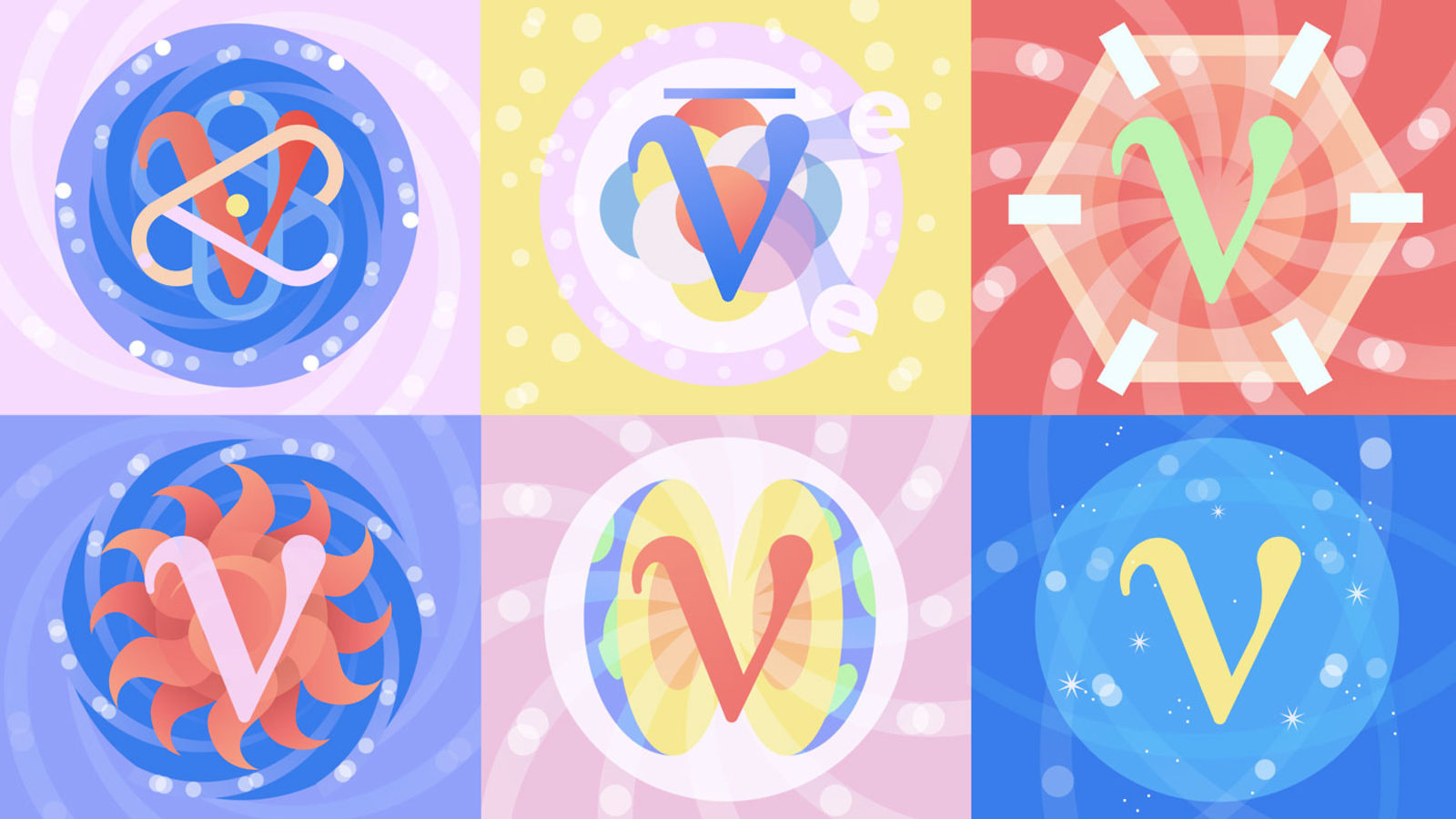
At the very end of the 19th century, when physicists were already seriously afraid that all possible laws were already open and the profession was no longer relevant, Becquerel discovered the effect of radioactivity, starting a new era in physics. In the process of studying this effect was divided into three types: alpha, beta and gamma radiation. The first was a stream of helium nuclei, the second was a stream of electrons and the third was a stream of photons. The radioactivity itself was represented as the transition of an atom from a state with high energy to a state with low energy, and the difference was exactly equal to the energy of the ejected particle.
Everything was good until James Chadwick in 1914 measured the energy of electrons resulting from beta decay. Instead of several clear lines, as was the case for all other types of radiation, he observed a continuous spectrum.
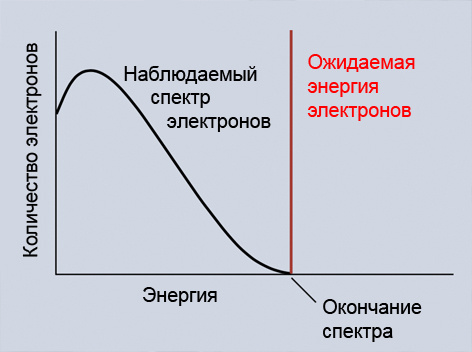
This made the scientific community think for a long time and review the very foundations of physics. Einstein, visiting Chadwick's lab, admitted that he had no idea how to explain such behavior, Debye wrote about this: "Oh, it’s better not to think about all this ... as new taxes." Niels Bohr himself encroached on the holy of holies - the law of conservation of energy. For several years he was convinced that this law was violated in the microworld and developed a corresponding theory.
After almost 20 years in 1930, Pauli suggested that there may be a light electrically neutral particle that carries away the missing energy. He called this particle a neutron. He formed his proposal in a letter to the Tubingham Scientific Congress (under the cut). Notable are the appeals of “Dear radioactive ladies and gentlemen”, “dear radioactives”, as well as the reason why Mr. Pauli himself did not attend the congress. He had a ball at night. Ladies will not wait until you open a new particle here.
But in 1932, the already mentioned James Chadwick discovered a neutral particle with a mass close to that of a proton and called it a neutron for consonance. To avoid confusion, the hypothetical Pauli particle was given the name "neutrino" (literally "neutron"). Pauli himself said that he had made an unforgivable mistake for a theorist: he proposed a fundamentally unregistered particle. He even argued with a colleague an astronomer for a bottle of champagne, which during his lifetime would not confirm his hypothesis. Looking ahead, I will say that Pauli lost the argument. Two years before his death, it was possible to observe the signal directly from the neutrino.
It is noteworthy that after more than 30 years of observation, the nature of the radioactivity was not really known. The process was as follows: something happens in the atomic nucleus, the charge is increased by one, the mass is saved and the electron flies out. That is why the neutron itself was discovered only decades later after observing its decay. In 1934, Enrico Fermi for the first time creates a coherent theory of beta decay. He uses the Pauli hypothesis about the existence of neutrinos. Now the process is as follows:
The theory brilliantly coincided with experiment for one small flaw. There is no evidence of the existence of neutrinos.
Began the search for an unknown particle. Fermi's theory gave very good clues as to how to look for such a particle. The beta decay reaction could be "scrolled" in different directions, in particular, to consider the capture of an anti-neutrino by a proton with the formation of a positron and a neutron.

It was easy to calculate the probability of such an event, but the result greatly puzzled physicists. In order for the interaction to occur exactly, the neutrino must travel a distance in lead of 10 million times the distance from the Sun to the Earth. This forced scientists to retreat from the search for neutrino interactions for a long time and try to seek indirect evidence.
The first indirect evidence was obtained already in 1936 by Alexander Ilyich Leipunsky. He proposed, and soon himself carried out studies of the reaction of the decomposition of the carbon isotope:
The initial carbon atom is at rest, so if the neutrino does not exist, then the total momentum of the boron atom and the positron should be zero. Since the particles of interest carry charge, the measurement of their impulses was not difficult. The experiment showed that the expansion of the boron atom and the positron is not compensated, which means that a certain particle, as expected, carries the momentum away.
The second version of the experiment was proposed in 1938 by Alikhanov and Alikhanyan and carried out in 1942 by Allen. The idea was to study the electron capture in the beryllium atom:
An electron from the lower orbital is with some probability located in the nucleus itself and can react with a proton to form a neutrino. Initially, the atom rests, and if a particle suddenly flies out of it, the resulting lithium atom should fly off to the other side. Experience has once again demonstrated the existence of a mysterious particle.
In this way, convincing evidence of the existence of a neutrino was obtained, but the direct detection of a particle remained unsolved for a long time and a very exciting task.
Here Raines and Cowan come on stage. The first of them during World War II and after it actively participated in the testing of nuclear bombs. So he has an idea to use a nuclear explosion as a source of neutrinos.

The original idea of the experiment was very, very unusual. It was planned to register reverse beta decay, but as already mentioned, such events are extremely rare. To increase the probability of interaction, a very large neutrino flux and a huge detector volume are needed.
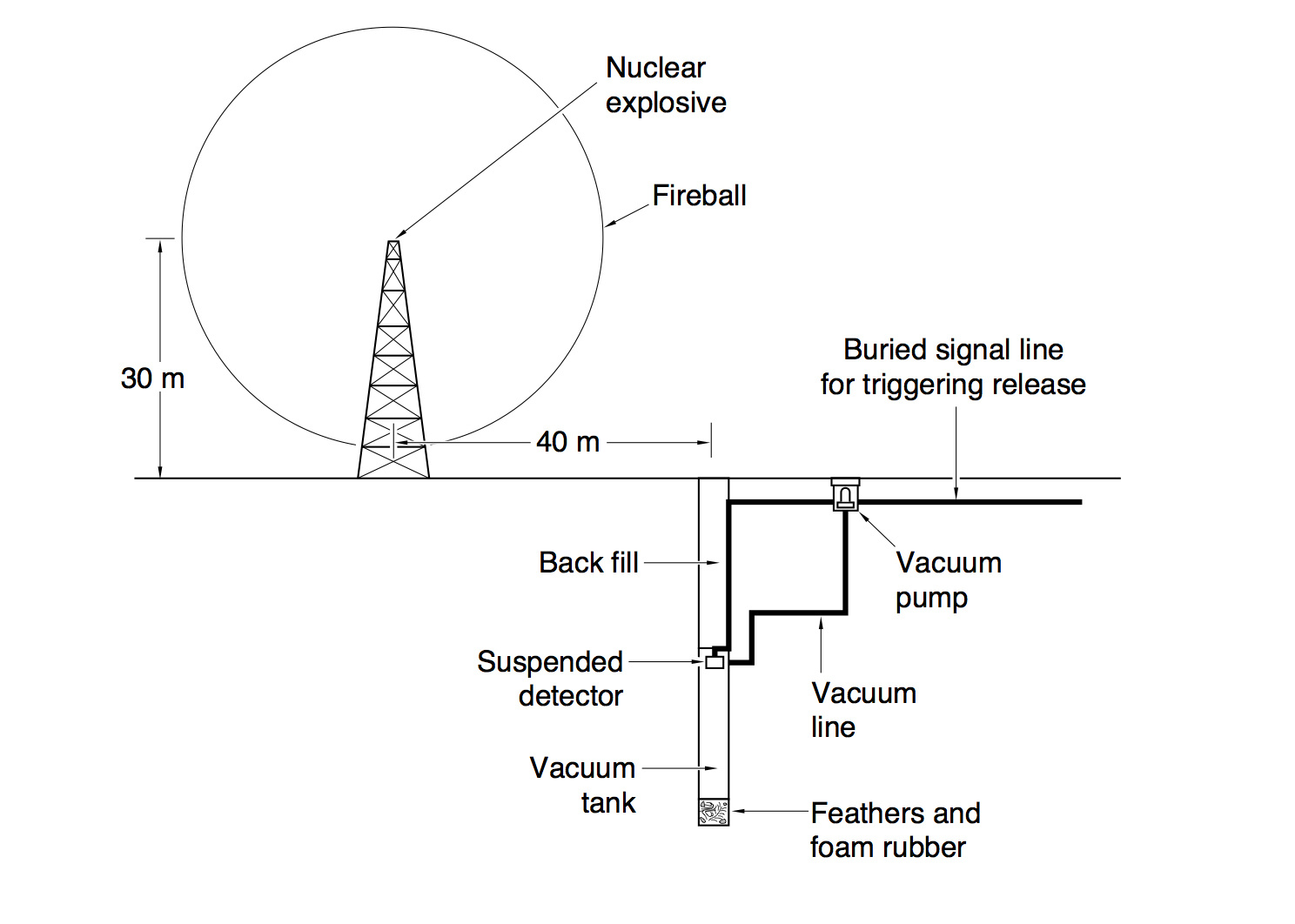
At 30 meter tower housed an atomic bomb with a capacity of 20 kilotons. Its explosion was supposed to be the source of a huge number of neutrinos. By the way, the "Kid", dropped on Hiroshima, had the same power. The times were simpler, for the sake of vague prospects of something there to register, the bombs did not shun to register, and the project received support. The closer to the epicenter of the explosion, the stronger the neutrino flux. But at the same time, the shock wave is stronger. The huge planned detector, weighing a ton, simply could not withstand such tremors. To protect the installation, it was decided to dump it into a vacuum shaft at the time of the explosion. Then the shock wave in the ground will not damage the detector, and after flying for a couple of seconds in free fall and registering several neutrino events, it will land gently on the rubber lining. A few days later, when the radiation situation on the surface became safe, the detector was planned to dig out and finally find out the secret of the neutrino.
My head does not fit, as developing a detector 1000 times larger than all existing in size, you can venture on such a bold experiment - dumping it into the mine in a long free fall.
But the original scheme was not destined to be realized. Investigating the possibilities to lower the background from the passing neutrons, gamma-quanta and other penetrating rays, the team decides in the desired reaction
register not only positrons, but also neutrons. For this purpose, it was planned to add cadmium to the detector, which will capture neutrons and highlight photons, which are already very easy to register.
The lifetime of the cadmium isotope 109m is only tens of microseconds. Thus, the signal from the neutrino interaction acquires a very clear signature: the positron almost immediately annihilates with the electron, highlighting a pair of photons with clearly defined energy, and after a few microseconds a second flash occurs - the result of neutron capture by cadmium and again with well-defined energy. Repeated suppression of the background made it possible to use as a source not a destructive nuclear bomb, but a completely peaceful reactor. In addition, this method allows you to spend months and years of exposure, getting more and more reliable results.
After developing the concept, scientists began to construct and test the detector. At that time it was a revolutionary installation. Then “large” was considered the volume of the detector in a liter, here it was planned to use a cubic meter of target, surrounded by 90 photomultipliers . For comparison, modern experiments, such as Super-Kamiokande, have a volume of 50,000 cubic meters and 13,000 PMTs are viewed. The planned Hyper-Kamiokande is 20 times larger and uses 100,000 PMTs.
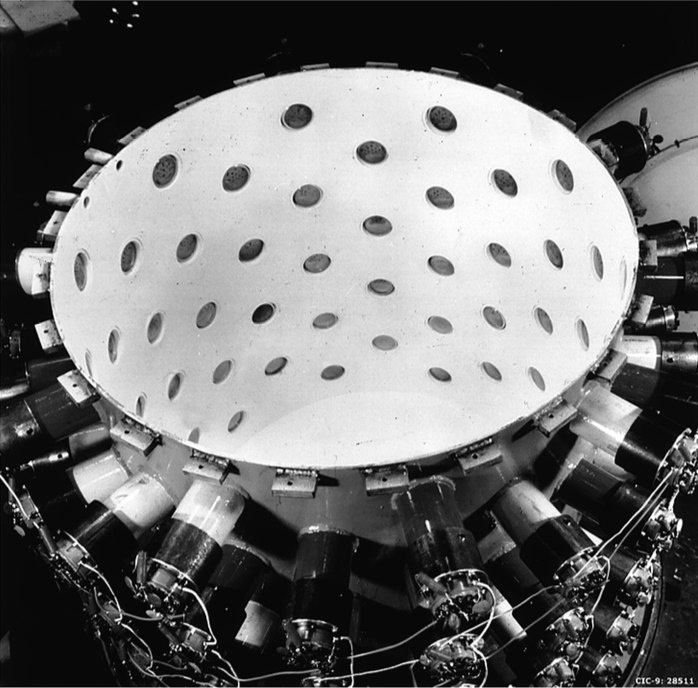
In 1953, a data collection session began at the Henford reactor. Background processes from other particles leaving the reactor caused the team a lot of trouble. It was necessary to constantly roll hundreds of tons of lead, to refine stalling equipment, electronics, giving false alarms, and so on. The team worked with full dedication, hoping for a breakthrough result. But despite all the efforts, the background from cosmic rays and electronics was too great. The statistics gathered when the reactor was turned on and off gave a hint that neutrino interactions did occur, but there was no definiteness. Nevertheless, a group of scientists, inspired by the first result, began to modernize the detector for further work.
The second stage of research was observations at the Savannah River reactor. The new detector consisted of two tanks of water and three cylinders filled with a liquid scintillator, a substance that glows when radiation passes through it.

The principle remains the same - to look for coincidences from two signals: positron annihilation and neutron capture. The choice of the reactor at Savannah River was due to the fact that it was a new, more powerful reactor, and in addition there was an underground, shielded room that significantly reduced the influence of cosmic radiation. The result was not long in coming, after only a few months, in June 1956, after numerous checks, irrefutable evidence of neutrino interactions was obtained. The door to the new physics was open!
Raines and Cowan promptly telegraph Paulie about his discovery.

Having received such a telegram, Pauli interrupted the meeting at CERN in order to read to the audience such important news. And after, in honor of this discovery, Wolfgang and his friends drank a box of champagne. Many years later, the text of the never-sent answer became known:
Independent confirmation of this result was obtained only 8 years later in an accelerator experiment. A repetition of the reactor experiment was carried out only after 20 years. Despite the high appreciation of the scientific community, the prizes were in no hurry to crumble on the heads of the discoverers of the most weakly interacting particle. The irony was even that in 1988, Lederman, Schwartz and Steinberger received the Nobel Prize for the discovery of a new type of neutrino - muon, for the very same fundamental discovery of neutrino that was given only in 1995 and only to Reines. Cowan did not live to that point.
Raines subsequently continued his research, measured the probability of the interaction of a neutrino with an electron, with a deuteron; for the first time registered the "natural" neutrinos born in the atmosphere, laid many of the foundations of this branch of physics.
There were still many amazing discoveries ahead: registration of new neutrino varieties , discovery of neutrino helicity , separation of neutrinos and antineutrinos, observation of oscillations , registration of neutrinos from a supernova explosion , search for CP violation . For the first time, astrophysicists were able to observe the Universe not through the observation of electromagnetic waves with the help of neutrinos. A huge number of powerful detectors were built and continues to be built to study this elusive particle.
In conclusion I want to say that there are neutrinos in each of us and in large quantities! Every second about 100 billion of such particles pass through a square centimeter on Earth.
Thus began the story of a completely new field in physics, which brought more Nobel Prizes than any other.

"Wrong" electrons
At the very end of the 19th century, when physicists were already seriously afraid that all possible laws were already open and the profession was no longer relevant, Becquerel discovered the effect of radioactivity, starting a new era in physics. In the process of studying this effect was divided into three types: alpha, beta and gamma radiation. The first was a stream of helium nuclei, the second was a stream of electrons and the third was a stream of photons. The radioactivity itself was represented as the transition of an atom from a state with high energy to a state with low energy, and the difference was exactly equal to the energy of the ejected particle.
Everything was good until James Chadwick in 1914 measured the energy of electrons resulting from beta decay. Instead of several clear lines, as was the case for all other types of radiation, he observed a continuous spectrum.

This made the scientific community think for a long time and review the very foundations of physics. Einstein, visiting Chadwick's lab, admitted that he had no idea how to explain such behavior, Debye wrote about this: "Oh, it’s better not to think about all this ... as new taxes." Niels Bohr himself encroached on the holy of holies - the law of conservation of energy. For several years he was convinced that this law was violated in the microworld and developed a corresponding theory.
The emergence of the idea of "unregistered" particle
After almost 20 years in 1930, Pauli suggested that there may be a light electrically neutral particle that carries away the missing energy. He called this particle a neutron. He formed his proposal in a letter to the Tubingham Scientific Congress (under the cut). Notable are the appeals of “Dear radioactive ladies and gentlemen”, “dear radioactives”, as well as the reason why Mr. Pauli himself did not attend the congress. He had a ball at night. Ladies will not wait until you open a new particle here.
Pauli's letter suggesting the existence of a neutrino 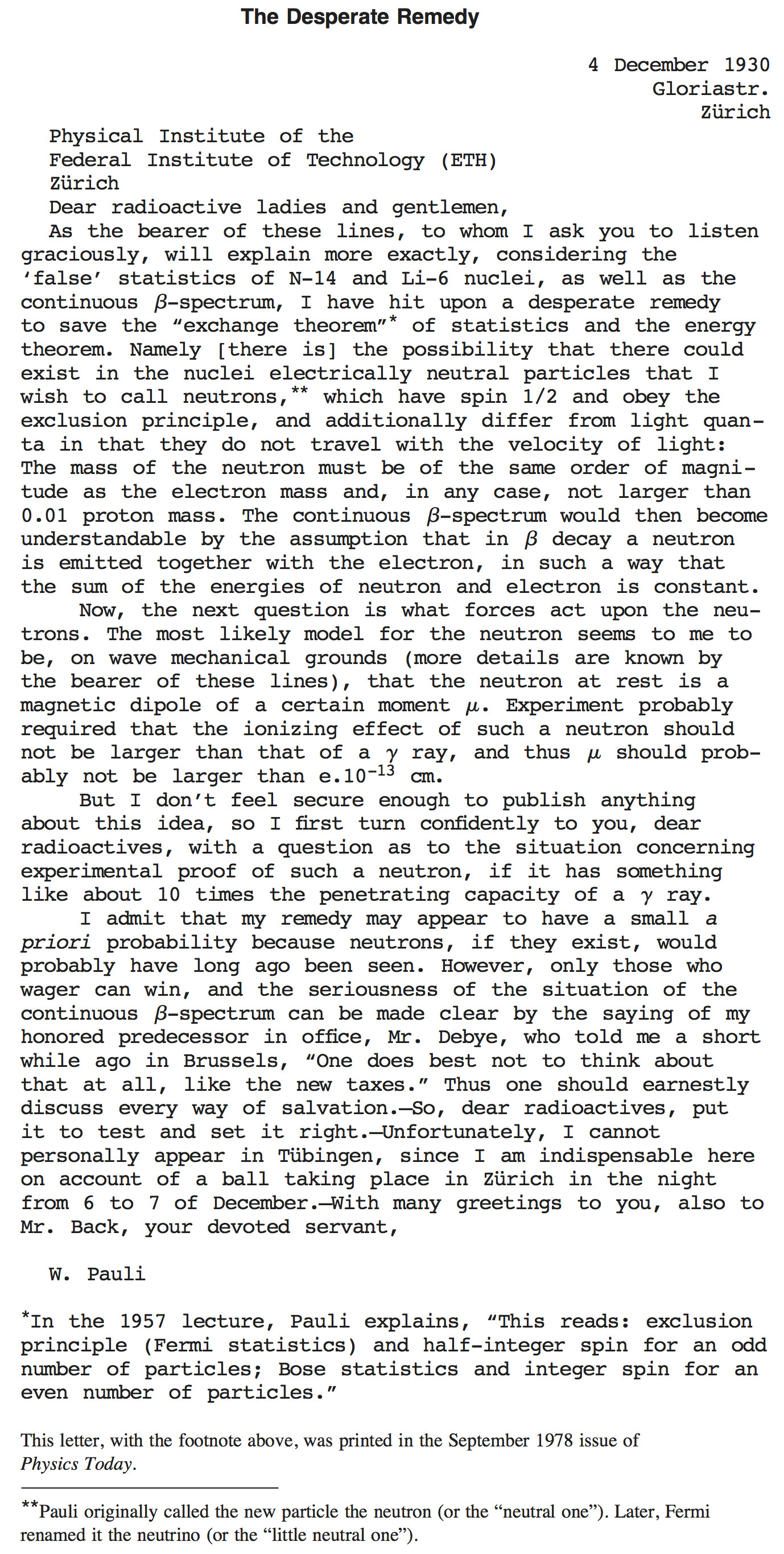

But in 1932, the already mentioned James Chadwick discovered a neutral particle with a mass close to that of a proton and called it a neutron for consonance. To avoid confusion, the hypothetical Pauli particle was given the name "neutrino" (literally "neutron"). Pauli himself said that he had made an unforgivable mistake for a theorist: he proposed a fundamentally unregistered particle. He even argued with a colleague an astronomer for a bottle of champagne, which during his lifetime would not confirm his hypothesis. Looking ahead, I will say that Pauli lost the argument. Two years before his death, it was possible to observe the signal directly from the neutrino.
It is noteworthy that after more than 30 years of observation, the nature of the radioactivity was not really known. The process was as follows: something happens in the atomic nucleus, the charge is increased by one, the mass is saved and the electron flies out. That is why the neutron itself was discovered only decades later after observing its decay. In 1934, Enrico Fermi for the first time creates a coherent theory of beta decay. He uses the Pauli hypothesis about the existence of neutrinos. Now the process is as follows:
The theory brilliantly coincided with experiment for one small flaw. There is no evidence of the existence of neutrinos.
Indirect evidence of the existence of "poltergeist"
Began the search for an unknown particle. Fermi's theory gave very good clues as to how to look for such a particle. The beta decay reaction could be "scrolled" in different directions, in particular, to consider the capture of an anti-neutrino by a proton with the formation of a positron and a neutron.

It was easy to calculate the probability of such an event, but the result greatly puzzled physicists. In order for the interaction to occur exactly, the neutrino must travel a distance in lead of 10 million times the distance from the Sun to the Earth. This forced scientists to retreat from the search for neutrino interactions for a long time and try to seek indirect evidence.
The first indirect evidence was obtained already in 1936 by Alexander Ilyich Leipunsky. He proposed, and soon himself carried out studies of the reaction of the decomposition of the carbon isotope:
The initial carbon atom is at rest, so if the neutrino does not exist, then the total momentum of the boron atom and the positron should be zero. Since the particles of interest carry charge, the measurement of their impulses was not difficult. The experiment showed that the expansion of the boron atom and the positron is not compensated, which means that a certain particle, as expected, carries the momentum away.
The second version of the experiment was proposed in 1938 by Alikhanov and Alikhanyan and carried out in 1942 by Allen. The idea was to study the electron capture in the beryllium atom:
An electron from the lower orbital is with some probability located in the nucleus itself and can react with a proton to form a neutrino. Initially, the atom rests, and if a particle suddenly flies out of it, the resulting lithium atom should fly off to the other side. Experience has once again demonstrated the existence of a mysterious particle.
In this way, convincing evidence of the existence of a neutrino was obtained, but the direct detection of a particle remained unsolved for a long time and a very exciting task.
Project Poltergeist or unexploded bomb
Here Raines and Cowan come on stage. The first of them during World War II and after it actively participated in the testing of nuclear bombs. So he has an idea to use a nuclear explosion as a source of neutrinos.

Reices's remarkable conversation with Fermi
From the Nobel lecture by Frederick Raines 1995 year.
It so happened that in the summer of 1951, Enrico Fermi was in Los Alamos. I timidly knocked on his door and said: "I would like to talk with you for a few minutes about the possibility of registering neutrinos." He was very friendly and answered: "Well, tell me what's on your mind?" I said: "First, as for the neutrino source, I think the bomb is best suited." After a short thought, he replied: "Yes, the bomb is the best source." Until now, everything was fine! Then I suggested: “But we need a very large detector. I do not know how to make such a detector. ” He thought a little and said he did not know either. This statement of the Master shocked me. And I left the idea before a casual conversation in Clyde Cowan.
The original idea of the experiment was very, very unusual. It was planned to register reverse beta decay, but as already mentioned, such events are extremely rare. To increase the probability of interaction, a very large neutrino flux and a huge detector volume are needed.

At 30 meter tower housed an atomic bomb with a capacity of 20 kilotons. Its explosion was supposed to be the source of a huge number of neutrinos. By the way, the "Kid", dropped on Hiroshima, had the same power. The times were simpler, for the sake of vague prospects of something there to register, the bombs did not shun to register, and the project received support. The closer to the epicenter of the explosion, the stronger the neutrino flux. But at the same time, the shock wave is stronger. The huge planned detector, weighing a ton, simply could not withstand such tremors. To protect the installation, it was decided to dump it into a vacuum shaft at the time of the explosion. Then the shock wave in the ground will not damage the detector, and after flying for a couple of seconds in free fall and registering several neutrino events, it will land gently on the rubber lining. A few days later, when the radiation situation on the surface became safe, the detector was planned to dig out and finally find out the secret of the neutrino.
My head does not fit, as developing a detector 1000 times larger than all existing in size, you can venture on such a bold experiment - dumping it into the mine in a long free fall.
But the original scheme was not destined to be realized. Investigating the possibilities to lower the background from the passing neutrons, gamma-quanta and other penetrating rays, the team decides in the desired reaction
register not only positrons, but also neutrons. For this purpose, it was planned to add cadmium to the detector, which will capture neutrons and highlight photons, which are already very easy to register.
The lifetime of the cadmium isotope 109m is only tens of microseconds. Thus, the signal from the neutrino interaction acquires a very clear signature: the positron almost immediately annihilates with the electron, highlighting a pair of photons with clearly defined energy, and after a few microseconds a second flash occurs - the result of neutron capture by cadmium and again with well-defined energy. Repeated suppression of the background made it possible to use as a source not a destructive nuclear bomb, but a completely peaceful reactor. In addition, this method allows you to spend months and years of exposure, getting more and more reliable results.
After developing the concept, scientists began to construct and test the detector. At that time it was a revolutionary installation. Then “large” was considered the volume of the detector in a liter, here it was planned to use a cubic meter of target, surrounded by 90 photomultipliers . For comparison, modern experiments, such as Super-Kamiokande, have a volume of 50,000 cubic meters and 13,000 PMTs are viewed. The planned Hyper-Kamiokande is 20 times larger and uses 100,000 PMTs.
First result

In 1953, a data collection session began at the Henford reactor. Background processes from other particles leaving the reactor caused the team a lot of trouble. It was necessary to constantly roll hundreds of tons of lead, to refine stalling equipment, electronics, giving false alarms, and so on. The team worked with full dedication, hoping for a breakthrough result. But despite all the efforts, the background from cosmic rays and electronics was too great. The statistics gathered when the reactor was turned on and off gave a hint that neutrino interactions did occur, but there was no definiteness. Nevertheless, a group of scientists, inspired by the first result, began to modernize the detector for further work.
The second stage of research was observations at the Savannah River reactor. The new detector consisted of two tanks of water and three cylinders filled with a liquid scintillator, a substance that glows when radiation passes through it.

The principle remains the same - to look for coincidences from two signals: positron annihilation and neutron capture. The choice of the reactor at Savannah River was due to the fact that it was a new, more powerful reactor, and in addition there was an underground, shielded room that significantly reduced the influence of cosmic radiation. The result was not long in coming, after only a few months, in June 1956, after numerous checks, irrefutable evidence of neutrino interactions was obtained. The door to the new physics was open!
Raines and Cowan promptly telegraph Paulie about his discovery.

Having received such a telegram, Pauli interrupted the meeting at CERN in order to read to the audience such important news. And after, in honor of this discovery, Wolfgang and his friends drank a box of champagne. Many years later, the text of the never-sent answer became known:
Thank you for message. Everything comes to the one who can wait. Paulie
Results and further work
Independent confirmation of this result was obtained only 8 years later in an accelerator experiment. A repetition of the reactor experiment was carried out only after 20 years. Despite the high appreciation of the scientific community, the prizes were in no hurry to crumble on the heads of the discoverers of the most weakly interacting particle. The irony was even that in 1988, Lederman, Schwartz and Steinberger received the Nobel Prize for the discovery of a new type of neutrino - muon, for the very same fundamental discovery of neutrino that was given only in 1995 and only to Reines. Cowan did not live to that point.
Raines subsequently continued his research, measured the probability of the interaction of a neutrino with an electron, with a deuteron; for the first time registered the "natural" neutrinos born in the atmosphere, laid many of the foundations of this branch of physics.
There were still many amazing discoveries ahead: registration of new neutrino varieties , discovery of neutrino helicity , separation of neutrinos and antineutrinos, observation of oscillations , registration of neutrinos from a supernova explosion , search for CP violation . For the first time, astrophysicists were able to observe the Universe not through the observation of electromagnetic waves with the help of neutrinos. A huge number of powerful detectors were built and continues to be built to study this elusive particle.
In conclusion I want to say that there are neutrinos in each of us and in large quantities! Every second about 100 billion of such particles pass through a square centimeter on Earth.
Sources
- A good, but already very outdated, and with a huge number of typos article on the history of neutrino physics
- Los Alamos Science Number 25 1997
- Nobel lecture of Frederick Raines 1995
- Lots of English Wikipedia
All Articles